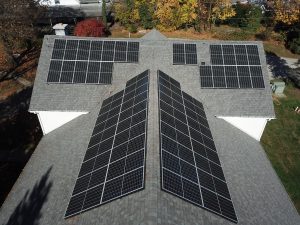
By Jon Marks
They call Chanukah the “Festival of Lights,” commemorating the time in the Temple when oil that was supposed to last for just one night lasted for eight.
But at 5 p.m. on Dec. 18 — just before the menorah is lit to signify the start of Chanukah — Congregation Beth Israel of Media will celebrate a different festival of lights of sorts.
The synagogue will dedicate 62 recently installed solar panels on its roof that will save energy and help deal with climate change. Rest assured, the panels will last much longer than eight nights.
“I love the message of Chanukah,” said Beth Israel Rabbi Nathan Martin, who, in conjunction with fellow Rabbi Linda Potemken, has spearheaded the effort over the past few years. “It talks about having the light you’re using last longer. It’s a great energy efficiency holiday — this notion that celebrating light and connecting to that fits nicely.”
For Martin, this is the culmination of a decade-long project that began after he took a training session with GreenFaith, a worldwide organization that encourages religious institutions to combat climate change. But the biggest obstacle faced was a lack of funding and getting the same kind of financial incentives and tax breaks as fossil fuel companies.

That changed with the passage of the Inflation Reduction Act in August, which provides a 30% tax credit for families installing solar panels while providing other ways for private institutions to take advantage.
“The synagogue had explored solar options before,” said Martin, who’s been at Beth Israel since 2015 after growing up in San Diego. “The challenge has been [that], until the passage of the Inflation Reduction Act, nonprofits were not eligible for federal tax credits.
“That made it trickier to figure out how to move forward. What we’ve have done is create an LLC (limited liability company) who bought the panels on the synagogue’s behalf. The synagogue pays them for a certain number of years from electricity saving it gets, and eventually it transfers back to the LLC, who’s able to get the tax credit.”
Money aspects aside, the bigger picture has to do with Beth Israel and other synagogues in the area “going green,” part of the tikkun olam repair the world credo.
“It’s a way that we can do our part, even if only in a small way, to help reduce global CO2 emissions,” Martin said. “That’s critical for much of the planet if we are to avoid the worst impacts of living in a warmed world. I also hope that this work continues to inspire us to work and advocate for communities facing immediate impacts of global warming and most affected by fossil fuel infrastructure.
“Installing solar panels should be one of the many actions that hopefully is a natural expression of our Jewish identity.”
GreenFaith leaders said there’s still opposition to the idea, some of which is political, some that is based on corporate greed and some due to ignorance.
“There’s not so much climate change denial,” said Rev. Fletcher Harper, executive director of GreenFaith, which advised Beth Israel. “Just general skepticism on political ideology. Folks realize it’s a slow end for fossil fuels. It’s important because it helps accelerate cultural, moral and political momentum. People see this can be done and should be done.”
It didn’t get done for Beth Israel until Martin saw the response to a presentation by a representative from St. Paul’s Lutheran Church in Ardmore.
“The other kippah I wear is head of the board of Pennsylvania Interfaith Power and Light, which is not a utility company,” he said. “I came across a woman who was helping her church purchase and install solar panels. She did a presentation to the folks on the board, and it got the wheels turning again.”
Getting the job done required people with technical skills, as well as someone who could handle complicated financial issues. But eventually, the $70,000 project, consisting of 62 panels, the majority of which are 3-feet-by-5-feet, were installed and activated.
Before that, Beth Israel implemented two other energy-saving measures, beginning in 2007, which the rabbi estimates have saved $16,000 a year. First, the synagogue switched from oil to gas to make the building’s lighting system more efficient. Then it did the same with the heating and cooling system.
Now it’s the solar panels, which Martin believes will save another $5-10,000 annually and can lead the way for others.
“We’ve had talented volunteers familiar with building operations working at this incrementally for 10-15 years,” he said. “But congregations can start anywhere. There’s still more work to do. … My hope is this will build energy and inspire people in the synagogue to take it into their own homes. The bottom line is we all need to be moving in a direction to cut down our carbon emissions.”



